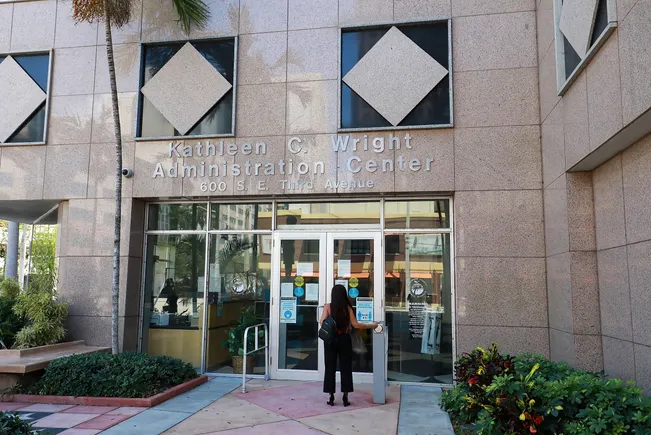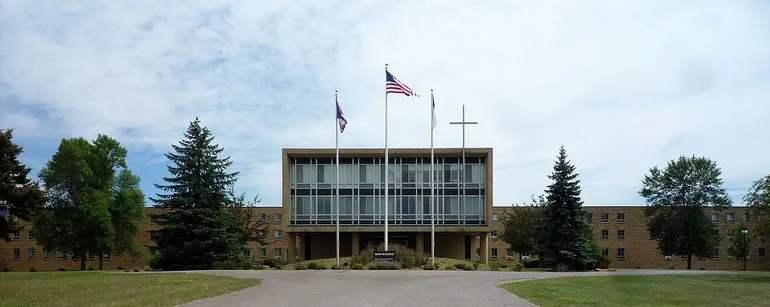A historically Black university in Maryland says efforts to boost enrollment and up its name recognition are paying dividends, allowing it to more than quadruple out-of-state student enrollment over the past two years.
Coppin State University in Baltimore announced in 2023 that it would begin offering in-state tuition to any student who lived in one of the 41 U.S. states and territories without an HBCU—as well as the District of Columbia, which has two HBCUs—through a program called Expand Eagle Nation. In 2024, the first year of the program, the institution more than doubled the number of students from qualifying states to 195—up from 81 the previous fall. (Coppin’s in-state annual cost of attendance is $27,410, versus $34,474 for out-of-state students.)
This fall, the numbers increased even more dramatically: 416 of Coppin’s incoming class of 1,000—its largest freshman class in 25 years—come from the qualifying states. Overall, Coppin’s enrollment is up 26 percent this year, including growth on the in-state side, as well. In fact, James Stewart, associate vice president for student development and achievement, said the attention Coppin has received for its Expand Eagle Nation program has raised the university’s profile among local students.
Still, it’s been a major shift for the institution, which used to attract students primarily from within a 50-mile radius.
“I think our students enjoy the diversity of thought from so many different regions,” said Jinawa McNeil, the university’s director of admissions. “This is really giving opportunity to students, but it’s [also] making Coppin a different environment, where you traditionally were with students that you might have went to high school with, or maybe a high school not far from you, but now you’re talking to students who are literally from states that you’ve never been to.”
Coppin’s growth comes at a time when many institutions across the country are working to attract new populations of students ahead of the impending demographic cliff—the decline in high school graduates that is expected to begin next year. (The Maryland Higher Education Commission projected earlier this year, however, that Maryland will be one of the few states to buck the trend, projecting an 11 percent increase in high school graduates from 2024 to 2031.)
Coppin isn’t the only institution looking to out-of-state students to boost enrollment; in an interview earlier this fall, University of Connecticut officials attributed their growth in head count to more out-of-state name recognition due to the institution’s academic programs and popular sports teams, for example.
“Given the declining number of students in their own state, [colleges] have to chase them elsewhere,” said Gregory Price, a professor of economics at the University of New Orleans who studies the economics of HBCUs. “It’s sort of like an arms race.”
Coppin is also capitalizing on the current popularity of HBCUs, which saw significant increases in applications and enrollments following the Supreme Court’s 2023 ban on affirmative action in admissions.
“Everything that’s been going on politically, from affirmative action to DEI, sends a message to Black students that they don’t belong,” Henry Williams, president of the Thurgood Marshall College Fund, a nonprofit that advocates for public HBCUs, told Inside Higher Ed regarding the trend last year. “At an HBCU, you’re never going to have that question, and all of the support, resources and scholarship money being taken away elsewhere are already built into the structure [at HBCUs] … there’s value in a sense of belonging.”
Price noted that HBCUs are also often cheaper than other institutions—as is the case at Coppin, which says it’s the least expensive institution in Maryland. That’s because historically, HBCUs haven’t had large research enterprises, which saves the institutions many costs, he said; they can also attract faculty without paying salaries above market rate.
“To the extent HBCUs have a distinct value proposition for Black students, that could be good because there aren’t many HBCUs … and that value proposition is high returns in the labor market relative to the cost of attendance,” he said. “If you can reduce the costs, you could probably stay ahead of that demographic cliff longer than other colleges can.”
Bolstering Recruitment
Along with offering in-state tuition to out-of-state students, Coppin officials took a slew of steps to increase their presence in the states from which they hoped to attract students. That included visiting high schools—and plastering advertisements on buses and billboards in those cities ahead of their visits, so students would hopefully already recognize the Coppin brand by the time they met an admissions official.
The university formed transfer partnerships with community college systems in Colorado and California, and the admissions team reached out to regional organizations that help students in the college search process to ensure their staffs were aware of Coppin.
Increasing the university’s name recognition was an important goal of the Expand Eagle Nation program, McNeil said.
“It [used to be] a much harder recruitment sale, for lack of a better term,” she said. “We were beginning with who were as an institution, rather than saying, ‘Oh, you’ve heard about us, so let’s help you learn more.’”
Stewart also noted that the university was prepared for the enrollment boost, having met with academic affairs staff over the past year to ensure there would be enough courses and faculty to meet the needs of all students. To house the influx, Coppin is currently constructing a new dorm, slated to open next fall; it also has six off-campus apartment facilities that Stewart said include resident assistants, just like on-campus housing, and regular shuttle access to campus.
“We’re going to end up with a good mix where we increase our housing on campus, especially, to meet our new students, but we have options for our [upperclassmen] off campus that give them this blending of what real-life living in an urban environment is,” he said.
One unexpected challenge that has come with implementing Expand Eagle Nation? Convincing prospective students that the offer is real.
“They [don’t] believe it,” McNeil said. “Like, ‘What’s the trick, what’s the catch?’ They just don’t believe an institution was willing to invest that deeply, because students understand, and definitely parents of students, specifically parents that have been to college and might have some college debt. They just did not believe that this was an opportunity, because they don’t see too many opportunities like this.”










